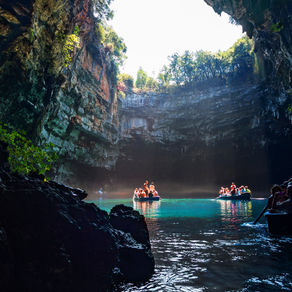Akrotiri Ruins Santorini | Is it Plato's Lost Atlantis or Land of the Minoan Civilization?
- Shiny Greece
- Sep 28, 2021
- 3 min read
Updated: Mar 27
Author
George - The Shiny Greece Team (feat. ai)
Akrotiri Santorini (Ακρωτήρι Σαντορίνη in Greek) was a settlement of the Bronze Age of Cyclades, a small fishing village of the past that developed significant trade relations with other cultures of the Aegean, as a middle station of the copper axis between Cyprus and Crete. This place, which is said to have inspired Plato (in the dialogues “Timaeus” and “Critias”) to write the story of the lost continent of Atlantis, has been associated with the civilization of the Minoans due to similarities in art and inscriptions in the Linear A ancient writing system.

Akrotiri Ruins Santorini | Photo by: iStock.com, s99
Is Akrotiri Worth Visiting
Excavations that started in 1967 in Akrotiri Santorini Greece brought up remarkably preserved community systems, such as water and drainage, paved streets, unique craft, multiple-story buildings and more. The Akrotiri Ruins Santorini have a level of preservation similar to Pompeii’s. Akrotiri was not one of the first excavations on the island. Before Akrotiri Santorini Grecia, there were the excavations of Ancient Thera in Mesa Vouno (archaic) and in Potamos area. The most valuable results of the excavations in Akrotiri are definitely the frescoes found, which provided to the archaeologists more information on the Minoan civilization than the frescoes of Knossos in Crete, being better preserved. The frescoes found in Akrotiri in Santorini are the fresco part with the head of an African, the fresco part with the head of a blue monkey, the fresco part with the large flying blue birds, the big fresco of the Blue Monkeys, the Spring fresco (perfectly preserved and still standing in its original installed position), the Fisherman fresco and the Lady from the House of Ladies fresco.

The Akrotiri Archaeological Site | Photo by: Rt44, Ancient Akrotiri, Cropped by Shiny Greece, CC BY-SA 4.0
Apart from the Akrotiri Santorini Frescoes, the numerous artifacts of the excavation have been installed in the Akrotiri Santorini Museum. These are the Golden Goat, the small shrine with a marble figurine of a woman, large jars for storage of goods, stirrup jars for transfer of commodities, bathtubs, flowerpots, vases, beds, offering tables, and more (find more in Akrotiri Wiki).
Where are the Akrotiri Ruins
Click on the Map to Find your Way through GoogleMaps
Santorini Akrotiri is close to the Akrotiri Lighthouse.
Akrotiri Santorini Weather
Akrotiri Santorini Tickets
According to the Ministry of Culture, the tickets are:
Full: €12, Reduced: €6
But mind to communicate with them in case of changes:
Telephone numbers: +30 22860-25405, +30 22860-81939, 210-33.10.280, 210-33.10.966
Email: efakyk@culture.gr
Free admission days
6 March (in memory of Melina Merkouri)
18 April (International Monuments Day)
18 May (International Museums Day)
The last weekend of September annually (European Heritage Days)
28 October
Every first Sunday from November 1st to March 31st
Holidays
1 January: closed
25 March: closed
1 May: closed
Easter Sunday: closed
25 December: closed
26 December: closed
Special ticket package: €15
The single ticket lasts 3 days and concerns Archaeological Sites and Museums of Thera: Archaeological Site of Akrotiri, Archaeological site of Ancient Thera, and Museum of Prehistoric Thera. The single ticket can be obtained from the archeological site or the museum you choose to visit first. Valid for: Akrotiri of Thera, Ancient Thera, Prehistoric Thera Museum.

Akrotiri Santorini Museum | Photo by: Nadia Prigoda from Toronto, Canada, Akrotiri golden goat, CC BY 2.0
Summer Opening Hours
08:30 - 15:30 (Monday, Wednesday, Thursday)
8:00 - 20:00 (Tuesday, Friday, Saturday, Sunday)
Akrotiri Santorini Restaurants
We propose:
The Edge
Glaros
Misteli
Akrothiri
Caldera Romantica

































































Thank you for this visit!!!!
People had indoor toilets and a sewage system forty centuries before the golden age of Pericles. Impeccable facilities!!! 😮